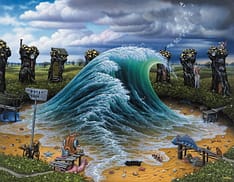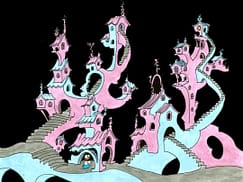In recent years, the skyscraper has come to be seen as the architectural symbol of globalization. Where France once built cathedrals and China constructed pagodas, most countries now raise the same culturally indistinct steel and glass structures. Last year alone, countries and companies around the world built 1 that, for the most part, all look the same.
What globalization hasn’t changed is the Babel-like race to the heavens that has been underway since ancient times. The Slovak graphic designer Martin Vargic of Halcyon Maps recently charted its course in six eye-opening infographics that visualize the architectural aspirations of the world’s most populated continents. “[Tall buildings] have a lot to do with a sense of monumentality, pride, and exceptionality,” Vargic told Hyperallergic. “There is certainly also a competitive element.”
In South America, the 164-foot-tall Huaca del Sol pyramid must have seemed enormous when it was finished in 450 CE, but it’s now dwarfed by the 984-foot-tall Gran Torre Santiago, which was completed in Chile last year. Similarly, the 160-foot-tall Roman Colosseum might have been Europe’s tallest building in 80 CE, but the under-construction, 1,227-foot Federation Tower in Moscow now holds the title. With buildings like the Burj Khalifa in Dubai, which soars to 2,722 feet, it’s hard to imagine things getting much taller. But, if history is any indication, it won’t be long before someone tries.
h/t ArchDaily












